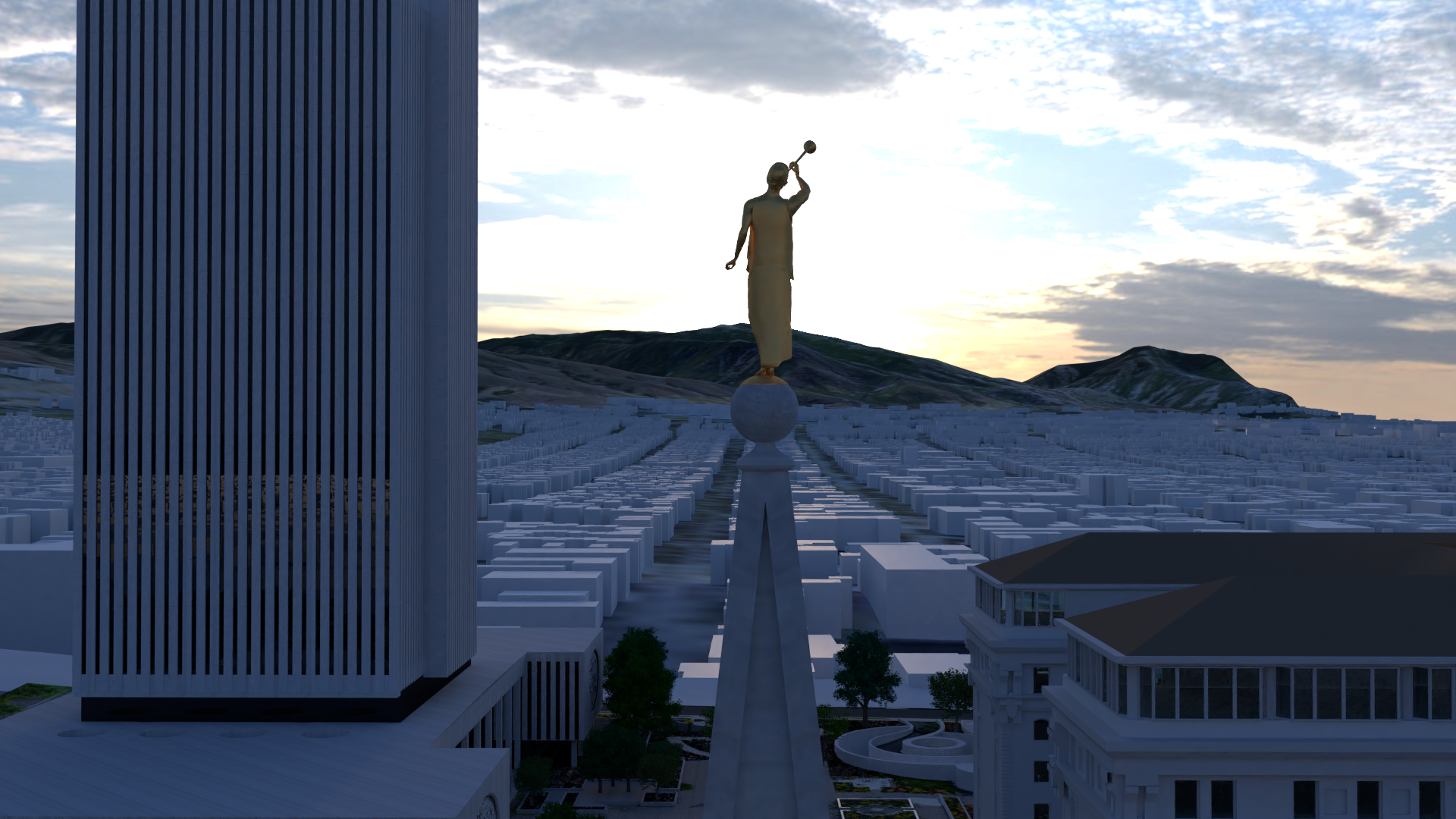
Dallin’s Moroni
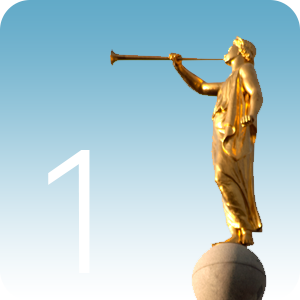
| COMMISSIONED | 19 August 1891 |
| MATERIAL | Hammered Copper |
| HEIGHT | 12’ 5.5” (3.8 Meters) |
| WEIGHT | 1,500 lbs. (680.4 kilograms) |
| CURRENTLY ON | 1 Temple |
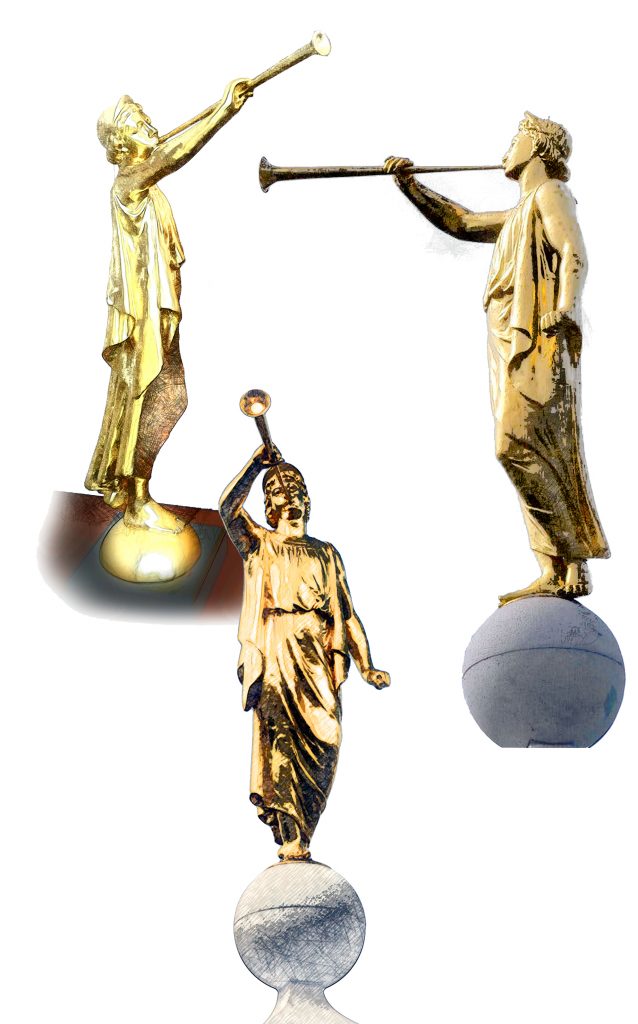
Center and Right, two views of the Salt Lake Temple Angel Moroni (1892)
Creation of an Icon
An early sketch by William Ward, assistant Architect to Truman O. Angel, shows a likeness of the temple as was planned by Angell and Presidents Brigham Young. While easily recognizable as the Salt Lake Temple there are a few differences between it and the temple as it was finally built. This early drawing shows the spires as metal clad steeples. Atop the center east and center west spires are weathervanes similar to the one placed atop the Nauvoo Temple. But while weather vanes were still in fashion when construction of the temple began, fashions do change.
Joseph Don Carlos Young became Church architect after Truman Angell’s death in 1887. Brigham Young had passed ten years before in 1877. Plans for the Salt Lake Temple were undergoing major changes. Among these were new plans drawn up in 1889 by Don Carlos for the spire. Gone were the shinning tin spires of Brigham and Truman’s original ideas. The new spires were constructed out of granite block. Part of this change was to allow for the placement of a Statue, rather than the weathervanes of Truman Angels design.
Commission
It was President Wilford Woodruff who in 1891 approached Cyrus Dallin with a commission. President Woodruff had sat several hours for a bust of himself that had been done by Dallin,[1]Wilford Woodruff journals and papers, 1828-1898; Wilford Woodruff journals, 1833-1898; Wilford Woodruff journal, 1886 January-1892 December; Church History Library, (accessed: August 12, 2019) and was impressed with his ability. [2]Florence S. and Jack Sears, “How We Got The Angel Moroni Statue,” Instructor 88 (October 1953): 292 He asked Dallin if he would be willing to sculpt an angel for the top of the Salt Lake Temple. The request was for a single standing statue more in the modern style, and only one, for the East center spire of the temple. President Woodruff makes no mention of the Commission or request in his journals, He does, however, make mention of one day when, after sitting a couple of hours for his bust, he drove out to his farm in the company of Mr. Dallin. Unfortunately, that is all he mentions of the event, but one can imagine the venerable President of the Church taking the opportunity of a leisurely drive in a carriage to talk to the young sculptor about plans for the temple spire.
The Story
Many articles and authors have related the story, often with differing stories as to how the conversation went. There is no contemporary source for how the event came about, but there are plenty of stories. And occasionally they even agree. Putting all of the (unverifiable) stories together, the event came about something like this:
Dallin, then a young man, was troubled by the request. He was concerned in not having a proper “pattern” to work from.[3]John H. Haslem Biography, December 1969 boydehouse.com. In an excerpt from Joh H. Haslem’s Journal he recounts a story related by Cyrus E. Dallen [sic] at the funeral of his uncle, George Bennett. According to this story, Dallin, in need of money for he and his wife, was summoned to Salt Lake by the President. Though Cyrus did not know the reason, his mother did, and cautioned him to be open minded and take the Job. In this accounting, Dallin declined both because he had no “pattern” to base the statue on, and he “didn’t believe in angels and he knew there was no such thing.” This story recounts that the President encouraged him to go home, and that they “all pray about it,” he being certain Cyrus would change his mind. This accounting includes the statement of Cyrus’s mother, “I don’t believe it. You called me your angel mother many times.” Cyrus then got the idea to use his mother as the pattern, and would later apologize for it being feminine. He felt that, perhaps, such a sculpture should be undertaken by someone of a more serious and spiritual nature.[4]Florence S. and Jack Sears, “How We Got The Angel Moroni Statue,” Instructor 88 (October 1953): 292 While he felt himself an able artist, he did not feel certain he was a good fit for this project.[5]Florence S. and Jack Sears, “How We Got The Angel Moroni Statue,” Instructor 88 (October 1953): 292
Dallin met with President Woodruf, who explained about the soon to be completed temple, how it would be a light to the nation- to the whole world.[6]Florence S. and Jack Sears, “How We Got The Angel Moroni Statue,” Instructor 88 (October 1953): 292 He told Dallin all about the plans for the east center spire of the temple, and what they hoped to place there.[7]Florence S. and Jack Sears, “How We Got The Angel Moroni Statue,” Instructor 88 (October 1953): 292
Upon hearing of the job, and receiving the request, Dallin declined, saying he had no pattern of an angle to work from, and that he never worked without a pattern.[8]John H. Haslem Biography, December 1969, boydehouse.com. He further more declared he did not believe in angels,[9]Francis, Rell Gardner 1928-2008. Cyrus E. Dallin: let justice be done / Rell G. Gardner Springville, Utah: published for Springville Museum of Art in cooperation with Utah American Revolution Bicentennial Commission, [1976] Provo, Utah : Press Publishing, (accessed: August 12, 2019), Notes to Chapter 3, The Author, Rell G. Francis recounts having attended a quarterly Stake Conference in Springville Utah, on 22 March 1942 where Levi Edgar Young, a known friend of Cyrus Dallin, recounted the story of Dallin telling the President he “didn’t believe in angels.” and new there was no such thing.
President Woodruf, not willing to take no for an answer, suggested he should go home and discuss it with his mother. Meanwhile, he said, they could all pray about it, after which he was certain Dallin would choose right,[10]Florence S. and Jack Sears, “How We Got The Angel Moroni Statue,” Instructor 88 (October 1953): 292 that Cyrus would come back and take the job.[11]John H. Haslem Biography, December 1969, boydehouse.com. But Cyrus said he didn’t believe in prayer either[12]John H. Haslem Biography, December 1969, boydehouse.com. and that he would not take the job.
Upon returning home via the train, he was met at the station by his mother, Jane Hamer Dallin. She was, apparently, concerned for his safety on the trip, he being only nineteen[13]John H. Haslem Biography, December 1969, boydehouse.com. (though he had already traveled by himself to Paris and New York for school.) She was also anxious to ensure that he had, in fact, taken the job.[14]John H. Haslem Biography, December 1969, boydehouse.com.
Dallin, frustrated over the event, then told his mother all about the discussion with President Woodruff, the outcome and all that they had said.[15]Florence S. and Jack Sears, “How We Got The Angel Moroni Statue,” Instructor 88 (October 1953): 292 He related to her all his concerns over the project. He had no pattern to work from. Surely such a subject for a sculpture should be undertaken by someone of a more serious nature.[16]Florence S. and Jack Sears, “How We Got The Angel Moroni Statue,” Instructor 88 (October 1953): 292 He was an able artist, to be sure, but he was by no means certain he was a good fit.[17]Florence S. and Jack Sears, “How We Got The Angel Moroni Statue,” Instructor 88 (October 1953): 292 He did not even believe in angels, after all.
She replied “Why do you say that? I do not believe it. You call me your ‘angel mother.’”[18]John H. Haslem Biography, December 1969, boydehouse.com.
”Dear Mother,” he said,” what should I do? Do you sincerely think that I am spiritually qualified to do this angel statue?”[19]Florence S. and Jack Sears, “How We Got The Angel Moroni Statue,” Instructor 88 (October 1953): 292
After a moment’s thought she replied “Cyrus, I am convinced —absolutely sure, that you should make the angel statue.” [20]Florence S. and Jack Sears, “How We Got The Angel Moroni Statue,” Instructor 88 (October 1953): 292
It was then that Dallin realized that he had a “pattern” for the statue after all, in the in the form of his angel mother.[21]John H. Haslem Biography, December 1969, boydehouse.com. Or so the story goes.
Of course we do know that Dallin did, whether immediately or after some discussion with the Prophet and then his Mother, accept the commission. But sadly, historical records do not either confirm or refute most of the story as it is often related.
Some sources indicate that he apologized after the statue was completed because it looked so feminine, his mother having been the model for the statue. (Compared to Angel statues to come, it is a thinner, more graceful body type, with less bulk on the arms and shoulders.)[22]John H. Haslem Biography, December 1969, boydehouse.com.
By 21 July of 1891 Dallin had submitted drawings for a freestanding angel statue, and the plan, along with plans by Don Carlos Young for spire toppers for the other 5 spires were accepted by the first Presidency on 19 August of the same year. [23]Albert L. Zobell, Jr, “Cyrus Dallin and the Angel Moroni Statue,” Improvement Era 72 (April 1968):5:6.
Casting
Dallin first sculpted a small working model of the statue, commonly called a maquette (pronounced mah-ket.) Dallin’s workshop was a room at the Gardo House, a mansion originally built for Brigham Young, which had become Church offices. This plaster model was finished 4 October 1891 and was exhibited at the Salt Lake Fair. At least two maquettes were made. One of these has been gold leafed and is on display in the Church History Library. The other of these is still plaster and has been used to model at least one other recreation of the Salt Lake statue. This all plaster model is currently in a vault in the Salt Lake Temple.
A full-size statue was next made from the original maquette. The statue was shipped to W. H. Mullins of Salem Ohio. There a mold was made of the full-size statue. Molten iron was poured into this mold, and the iron image was used to hammer copper sheets into the shape of the final statue. The trumpet was formed as a separate piece, to be added later.[24]Parshall, Ardis E. “The Day the Angel Moroni Almost Lost His Horn,” keepapitchinin.org, 23 August 2009. Once the statue was finished it was covered in 22 caret gold leaf, and returned to Salt Lake.
Counterweight
The inclusion of the heavy statue and capstone atop the temple spire meant that a method would be needed to ensure they remained firm atop the spire in the face of winds, tempest and earthquake. There was a concern that the statue, should it be allowed to move, would break the stonework beneath it.[25]Malin, Millard Fillmore 1891-1975. Millard F. Malin autobiographical sketch, circa 1966, (accessed: August 8, 2019) Modern use of welded steel infrastructure was still a few years away, so to make this possible, a one of a kind suspension system was created. The statue is mounted on a curved copper plate, also gilded, that rests on the top of the sphere. The plate matches the curve and shape of the. A steel rod, 1 ¼ inches in diameter, attaches to the underside of the plate, and runs down through the center of the sphere. The sphere is two pieces, split along the horizontal center of the ball. The sphere itself is hollow. Within the sphere is a time capsule, one of two placed in the temple (the other being down in the foundation.) From the sphere, the rod continues down farther into the open center of the spire. Two more rods are connected to the bottom of the first. These new rods run diagonally away from each other inches away from the sloped interior of the spire pyramid.
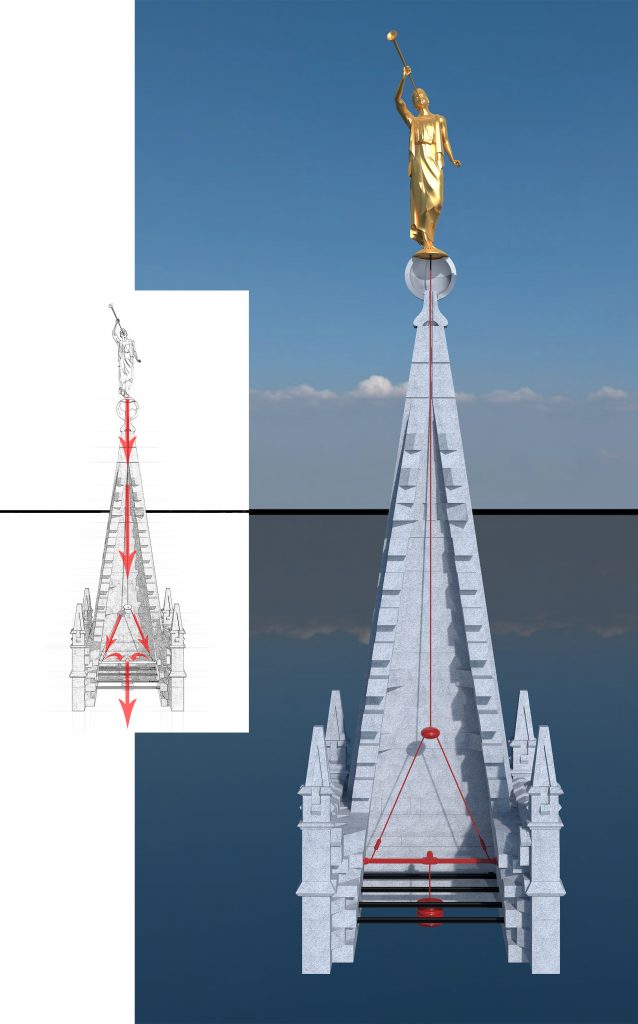
Lower down, levers with pivots on the end are bolted into the stone walls of the temple spire, where the pivot becomes a fulcrum placed near the wall. The 2 diagonal rods connect to these levers near their fulcrums. The weight of the statue causes these levers to pull up as the statue’s weight causes it to want to shift and move, and potentially topple over the side of the sphere. However, each of these two levers are connected at their opposing ends, in the center of the spire, to a single weight that pulls the levers down. As the levers are pulled back down, they pull down on their connecting rods, which in turn pull down on the single rod attached to the statue. This keeps the statue not only upright, but firmly pressed to the granite sphere.
Additional Anchoring
Photos taken by the Deseret News in 1952 show an interesting addition to the traditional description of the anchoring system.[26]Deseret News Press (Corporation). Deseret News Press photograph archives (negatives only), 1950-2000, (accessed: August 12, 2019) In 1952 scaffolding was erected around the spire so that the statue could be cleaned, repaired, and re-leafed. On 30 June of 1952, a Deseret News Photographer joined workers on the scaffolding and captured several up-close photos of the process. These photos show that at some point, either during the original placement or later on, bolts had been driven through the curved disc into the granite sphere to assist with anchoring the statue. It is unknown if these were part of the initial system or added later, but drone footage taken recently shows the bolts are still there even now.
Interestingly, the photos also show that large plates had been wrapped around the statues ankles and riveted into place. These plates were not part of the statue originally and are not on the statue now. It is possible that these plates were added later. They may have been made necessary due to naturally occurring weathering. It is also possible that they were added as part of the repairs needed after a bombing at the Hotel Utah Construction site in 1910. (Discussed later in the book.)
Placement
Just 5 months after the completion of the initial maquette, the full-sized finished statue assumed its place. On 6 April 1892 the capstone of the Temple was placed upon the spire at 12:15 p.m.. 40,000 people crammed onto temple square, thousands more filled the streets and watched on as an electric winch was used to lower the stone into place. ple was placed upon the spire at 12:15 p.m.. 40,000 people crammed onto temple square, thousands more filled the streets and watched on as an electric winch was used to lower the stone into place.
Later that afternoon the Angel statue was lowered into position atop the capstone. Workers inside the spire connected the counter weight system inside the spire, firmly anchoring the statue in place.
President Woodruff asked Cyrus Dallin, in attendance at the ceremony, “Now Dallin, do you believe in angels?” After some thought, Dallin replied “Yes, I believe in angels because my mother is an angel.”[27]Florence S. and Jack Sears, “How We Got The Angel Moroni Statue,” Instructor 88 (October 1953): 292
During the 1920s Dallin stopped by Temple square on a visit in Salt Lake. While there he ran into an old friend of his, Elder Levi Edgar Young, then serving as a member of the first council of the Seventy and as president of the Temple Square mission. The two of them were sitting on the curb surrounding the seagull monument in front of the Assembly Hall. Looking up at the Moroni high above, Dallin told his friend “I consider that my angel Moroni brought me nearer to God than anything I ever did. It seemed to me that I came to know what it means to commune with angels from heaven.” [28]Levi Edgar Young, “The Angel Moroni and Cyrus Dallin, “ Improvement Era 56 (April 1953):234
Speaking in General Conference in 1950, Elder Young shared another quote from his friend Cyrus Dallin on the Angel:
To believe in angels marks one who lives near to his God. It is one of the most beautiful concepts a man can have. I am glad I came to believe that Moroni, whoever he was in history, came back to earth again as an angel from God’s throne. [29] Levi Edgar Young, 121st Semi-Annual Conference October 1950, The Church of Jesus Christ of Latter-day Saints, p. 116.
Description
Like the Nauvoo weather vane before it, Dallin’s statue wears robes, this time in layers, and a cap on its head. It holds a trumpet in the right hand and the right arm raises it skyward in proclamation. The left arm is at the statue’s side, both it and the left fist tense. Unlike the Nauvoo weather vane, the 12 foot 5 inch statue stands, always facing eastward, on a massive granite sphere 3 feet 8 inches in diameter. Like the Nauvoo weather vane before it, Dallin’s statue wears robes, this time in layers. An inner robe covers his body from shoulder to above the ankles. A second robe, somewhat like a vest, hangs over the shoulders and to just below his hips, and is open in the front.
A cap sits on the statues head. It holds a trumpet in the right hand and the right arm raises it skyward in proclamation. The left arm is at the statue’s side, both it and the left fist tense. Unlike the Nauvoo weather vane, the 12’ 5” inch statue stands, always facing eastward, on a massive granite sphere, 3 feet 8 inches in diameter. Like the Nauvoo weather vane before it, Dallin’s statue wears robes, this time in layers, and a cap on its head. It holds a trumpet in the right hand and the right arm raises it skyward in proclamation. The left arm is at the statue’s side, both it and the left fist tense. Unlike the Nauvoo weather vane, the 12 foot 5 inch statue stands, always facing eastward, on a massive granite sphere 3 feet 8 inches in diameter.[30]Florence S. and Jack Sears, “How We Got The Angel Moroni Statue,” Instructor 88 (October 1953): 292
When the temple was originally completed, it was illuminated at night using spotlights, plus the addition of lights in the spire toppers. Curved arms coming out of the pinnacle decorations had electric lightbulbs in a kind of upside-down chandelier. For the statue, the Angel had a curved pole coming directly out of the top of his head. This upside down “J” shaped addition had an electric light in the end. This light was used to light the face and front of the statue at night.[31]Historical Department journal history of the Church, 1896-2001 July; 1890-1899; 1892 April; Church History Library, (accessed: August 12, 2019)
The statue has a cable attached to the feet that runs down the outside of the spire. This is a grounding cable. It turns the whole of the statue into a lightning rod for the temple.[32]This is a personal observation using a telephoto lens, and reflects the current state of the statue.
Possible Inspiration
While the Angel Moroni statue, departure that it was from Nauvoo’s angel weathervane, may not have been a great departure from the fashion of the time. In the Church history library can be found a set of photos taken at WH Mullins Co in Salem Ohio.[33]W. H. Mullins Company of Salem, Ohio, (accessed: August 12, 2019) These photos were taken at the time the angel was being cast there. There are many interesting photos in this catalog entry, including one of a young Cyrus Dallin himself standing next to his creation. Also included in the set are photos of WH Mullins himself, as well as many other projects being produced in his foundry at that time.
In one of these photos, taken outside the shop, shows many other statues created at the foundry. In this set can be seen two copies of winged angel, dressed in classically draped robes, and holding a trumpet in the right hand.
Another photo from the set shows a figure in a belted robe, more similar to modern angel Moroni statues, and holding a trumpet with both hands. This figure is wingless and, except for long curly hair and a two-handed trumpet hold, would not look amiss atop almost any temple. The design of Dallin’s Moroni would then appear to have been influenced by the styles of the day.
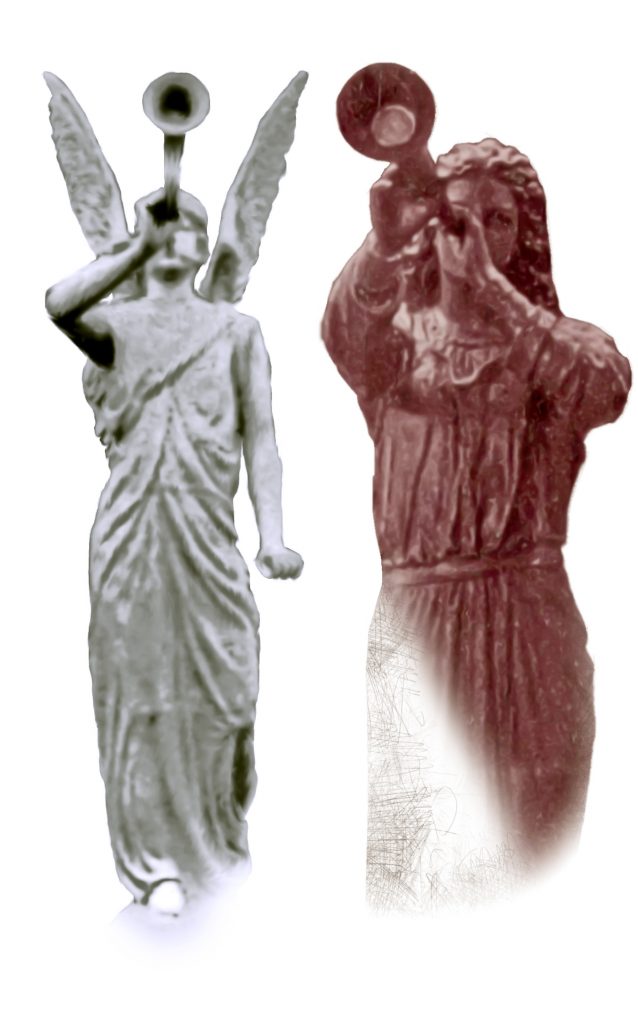
Removal for Renovation
On 7 April 2019, during the closing remarks for General Conference, President Russell M. Nelson announced pending renovations for the “pioneer temples,” in an effort to preserve what had been built at great cost and sacrifice.[34]Nelson, Russell M., “Closing Remarks,” ChurchofJesusChrist.org. April 2019 Shortly after the announcement, in a press conference, the full details of the plan for the Salt Lake Temple renovation were discussed in a press conference.[35]”Plans Unveiled for Salt Lake Temple Renovation,” Newsroom, 19 April 2019. The temple would undergoa an extensive seismic refit, with the inclusion of mass dampeners under the original structure capable of helping it withstand a 7.2 earthquake. The placement of the system would require removal of the mostly underground temple annex, completed in 1964, and replacement with a newer, reconfigured annex. Upgrades to mechanical and support systems, furnishings and finishes would be included.
It was originally planned that the Statue would be removed near the end of the renovation, at which point it would be refurbished. However, a 5.2 earthquake on 18 March of 2020 changed the renovation plans. Many of the spires atop the temple’s six towers shifted and moved in the quake. The trumpet in the hands of the Angel was lofted from his grasp, and landed in the parapets below, becoming badly mangled.
The decision was made to move the spire and statue removals up in the schedule, and so, on 18 May 2020 the statue and the granite sphere beneath it, weighing in at 3,800 pounds total, came off the spire for the first time since it was placed 128 years prior.[36]Walch, Tad, “Crane lifts damaged Angel Moroni statue off Salt Lake Temple,” Deseret News, 18 May 2020.
The Capstone Opened
Just a few days after the removal, the capstone was opened to get at the time capsule, known to be inside. The statue had already been separated from the Large quartz monzonite sphere, and it was hoped that the two halves of the ball could be popped apart fairly easily to get at what was placed inside on 2 April 1892.
Those hopes were quickly dashed as the sphere resisted all attempts to open it. As it would turn out, the builders of the temple felt it necessary to fill the sphere with concrete to protect the time capsule within, and presumably, further anchor the statue.
In the end, opening the sphere necessitated cutting open, and breaking into bits, the upper dome of the two part spire topper. The upper half of the was completely rendered useless. [37]In photos and video released by the Church of the opening event, large broken sections of the upper half can be seen lying in chunks all around the floor. “Salt Lake Temple Time Capsule Is Opened 128 Years Later,” Newsroom, 29 June 2020.
It turns out there was little inside the sphere to salvage. The Concrete, as it cured, released its moisture into the contents of the four part capsule. Portions of the collected items had been placed at each of the four cardinal points. Many of the items were still wet, though more likely from the local elements and the recent winter, when they were removed. Over time, the photos and books had essentially been glued together from decades of moisture.
The stone contained a copy of the Holy Bible, Book of Mormon (likely an 1880s or 1890s edition,) Doctrine and Covenants, Parley P. Pratt’s A Voice of Warning, Parley P. Pratt’s Key to Theology, Hymn Book, Compendium, Pearl of Great Price, The Martyrs: A Sketch of the Lives and a Full Account of the Martyrdom of Joseph and Hyrum Smith and 3 other books.
A stack of “Cabinet Cards,” photos placed on a backing card for easier handling, were also in the stone, including photographs of Joseph and Hyrum Smith, Brigham Young, John Taylor, Wilford Woodruff, George Q. Cannon, and Joseph F. Smith, a photograph of the Temple as it appeared at the time. While the photographs themselves are beyond preservation, as they were likely C. R. Savage photos, the originals are already to be had in the Church History Library. As of the writing of this, work was still being done to identify exactly which photos were in the Capsule.
Additionally, an engraved tablet of copper setting forth the principal dates in the history of the building and featuring the names of the general authorities of the Church as they stood April 6, 1853, and as constituted at the time of the capstone ceremony, April 6, 1892 was contained in the stone.
Most surprising was the inclusion of coins, dollar bills and notes that had been placed in the stone prior to it being sealed. Some of the coins featured names of individuals or families inscribed upon them.
Identity
Tradition over the creation of the statue holds that it was Dallin who chose the Angel Moroni as his inspiration for the statue atop the Salt Lake Temple.[38]“8 Facts about the Salt Lake Temple Angel Moroni” templesquare.com, 18 September 2014 The first edition of this book is guilty of spreading this story.
By some accounts, the first person to name the statues Moroni was Wilford Woodruff himself. In August 1891, President Woodruff asked Dallin to make a ‘statue representing the angel Moroni for the east spire.”[39] ref]Francis, Rell Gardner 1928-2008. Cyrus E. Dallin: let justice be done / Rell G. Gardner Springville, Utah: published for Springville Museum of Art in cooperation with Utah American Revolution Bicentennial Commission, [1976] Provo, Utah : Press Publishing, (accessed: August 12, 2019) This would be just after sitting for the bust of himself. If true then it appears that it was the Prophet who chose the identity of the statue, should the statement prove true.
That Woodruff adopted Moroni as the identity of the angel statue is supported by a letter Cyrus Dallin wrote to Gallen S. Young, dated 30 July 1938. In the letter Dallin said that he had been commissioned to sculpt a statue “of the Mormon Angel Moroni.”[40]Dallin, Cyrus Edwin 1861-1944. Cyrus E. Dallin letter, Arlington Heights, Massachusetts, to Gaylen S. Young, Salt Lake City, Utah , (accessed: August 12, 2019) This would indicate that the identity of the angel had been chosen even before the artist was selected for the work.
There are accounts of the placement of the angel where it was referred to as “The Angel of Revelation,” and another where it was referred to as the “Angel Gabriel”. However, the above stories would indicate that the statue has never been anyone other than Moroni. A Deseret News article about the placement refers to the Statue as Moroni, as have all official records since. This as well would indicate that the identity of the statue was known as Moroni at the time of its placement, if not so widely known as now.
For years there have been no actual details about how and when the identity of the statue came to be, but that changed in August 2020. At that time, Church Historian Emily Utt gave an interview to the Deseret News in which she gave further details on the history of the Statues Identity.
“Some of those earliest sketches don’t give him a name and some of those earliest sketches called him Gabriel,” Utt said. It’s likely that Dallin’s statue was originally Gabriel, which was very common at the time for churches.
Before the statue went on the Salt Lake Temple, Church leaders went to view it in Dallin’s studio. According to Utt, “One of the Apostles said, ‘We should call him Moroni.’ And within about a week, it was no longer being called Gabriel. It was being called Moroni…”
Utt said that no evidence has been found explaining why it needed to be Moroni, but the name stuck thereafter.
[41]Walton, Valerie, ”
Why do temples have the angel Moroni on top? Here’s look at the history of the iconic statues ,” The Church News, 30 July 2020.
It was Dallin’s statue then that linked the angel from the book of revelation with the prophet Moroni in the minds of the members of the church. However, it was not the start of the tradition of an angel on nearly every temple.
Identification Guide
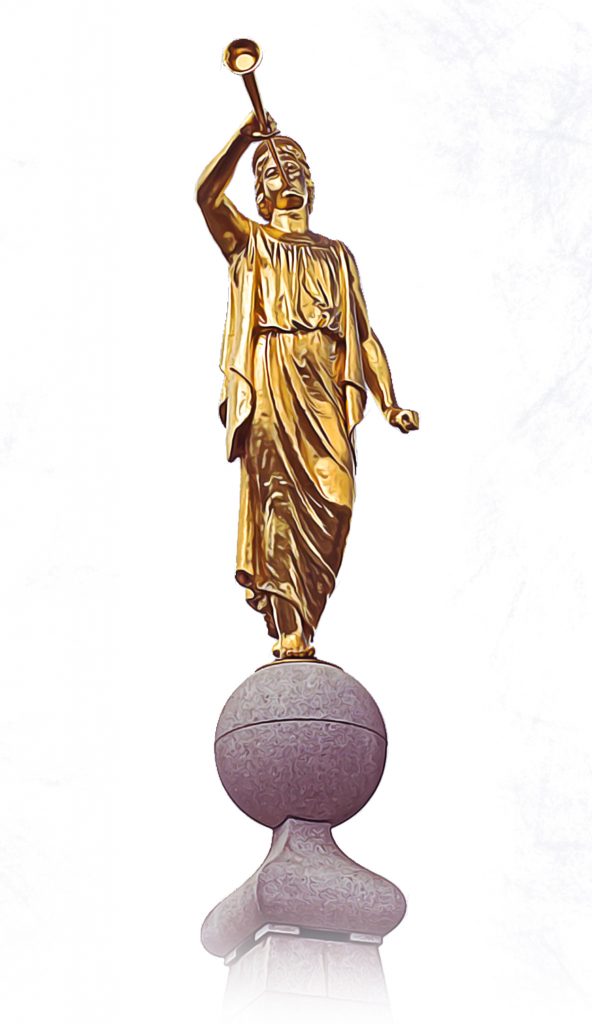
Cap
Dallin chose to sculpt Moroni wearing a cap with a short brim. From the front it can be seen sticking up above his hair. From the back it is more visible by the hair sticking out around the edges of the cap.

Bare Arms
This first Angel Moroni has bare arms. Most of the statues to come after would feature at least short sleeves

Cape
In addition to having robes, Dallin’s Moroni has a short cloak with arm holes. This gives a more layered look to the robe than most other Moroni Statues have.
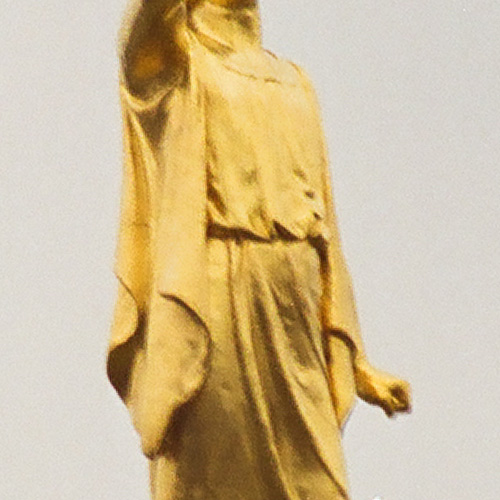
Granite Sphere
The Salt Lake Angel stands on a granite sphere that is significantly wider than main body of the statue. All later statues would have much narrower spheres. The Philadelphia Temple now features a statue on a granite sphere, but it is much narrower in comparison. Additionally, the Salt Lake sphere is topped with a curved gold cap that the Angel stands directly on.

Chapter 3 Navigation
Related Articles
References
| ↑1 | Wilford Woodruff journals and papers, 1828-1898; Wilford Woodruff journals, 1833-1898; Wilford Woodruff journal, 1886 January-1892 December; Church History Library, (accessed: August 12, 2019) |
|---|---|
| ↑2, ↑4, ↑5 | Florence S. and Jack Sears, “How We Got The Angel Moroni Statue,” Instructor 88 (October 1953): 292 |
| ↑3 | John H. Haslem Biography, December 1969 boydehouse.com. In an excerpt from Joh H. Haslem’s Journal he recounts a story related by Cyrus E. Dallen [sic] at the funeral of his uncle, George Bennett. According to this story, Dallin, in need of money for he and his wife, was summoned to Salt Lake by the President. Though Cyrus did not know the reason, his mother did, and cautioned him to be open minded and take the Job. In this accounting, Dallin declined both because he had no “pattern” to base the statue on, and he “didn’t believe in angels and he knew there was no such thing.” This story recounts that the President encouraged him to go home, and that they “all pray about it,” he being certain Cyrus would change his mind. This accounting includes the statement of Cyrus’s mother, “I don’t believe it. You called me your angel mother many times.” Cyrus then got the idea to use his mother as the pattern, and would later apologize for it being feminine. |
| ↑6, ↑7, ↑10, ↑15, ↑16, ↑17, ↑19, ↑20, ↑27, ↑30 | Florence S. and Jack Sears, “How We Got The Angel Moroni Statue,” Instructor 88 (October 1953): 292 |
| ↑8, ↑11, ↑12, ↑13, ↑14, ↑18, ↑21, ↑22 | John H. Haslem Biography, December 1969, boydehouse.com. |
| ↑9 | Francis, Rell Gardner 1928-2008. Cyrus E. Dallin: let justice be done / Rell G. Gardner Springville, Utah: published for Springville Museum of Art in cooperation with Utah American Revolution Bicentennial Commission, [1976] Provo, Utah : Press Publishing, (accessed: August 12, 2019), Notes to Chapter 3, The Author, Rell G. Francis recounts having attended a quarterly Stake Conference in Springville Utah, on 22 March 1942 where Levi Edgar Young, a known friend of Cyrus Dallin, recounted the story of Dallin telling the President he “didn’t believe in angels.” |
| ↑23 | Albert L. Zobell, Jr, “Cyrus Dallin and the Angel Moroni Statue,” Improvement Era 72 (April 1968):5:6. |
| ↑24 | Parshall, Ardis E. “The Day the Angel Moroni Almost Lost His Horn,” keepapitchinin.org, 23 August 2009. |
| ↑25 | Malin, Millard Fillmore 1891-1975. Millard F. Malin autobiographical sketch, circa 1966, (accessed: August 8, 2019) |
| ↑26 | Deseret News Press (Corporation). Deseret News Press photograph archives (negatives only), 1950-2000, (accessed: August 12, 2019) |
| ↑28 | Levi Edgar Young, “The Angel Moroni and Cyrus Dallin, “ Improvement Era 56 (April 1953):234 |
| ↑29 | Levi Edgar Young, 121st Semi-Annual Conference October 1950, The Church of Jesus Christ of Latter-day Saints, p. 116. |
| ↑31 | Historical Department journal history of the Church, 1896-2001 July; 1890-1899; 1892 April; Church History Library, (accessed: August 12, 2019) |
| ↑32 | This is a personal observation using a telephoto lens, and reflects the current state of the statue. |
| ↑33 | W. H. Mullins Company of Salem, Ohio, (accessed: August 12, 2019) |
| ↑34 | Nelson, Russell M., “Closing Remarks,” ChurchofJesusChrist.org. April 2019 |
| ↑35 | ”Plans Unveiled for Salt Lake Temple Renovation,” Newsroom, 19 April 2019. |
| ↑36 | Walch, Tad, “Crane lifts damaged Angel Moroni statue off Salt Lake Temple,” Deseret News, 18 May 2020. |
| ↑37 | In photos and video released by the Church of the opening event, large broken sections of the upper half can be seen lying in chunks all around the floor. “Salt Lake Temple Time Capsule Is Opened 128 Years Later,” Newsroom, 29 June 2020. |
| ↑38 | “8 Facts about the Salt Lake Temple Angel Moroni” templesquare.com, 18 September 2014 |
| ↑39 | ref]Francis, Rell Gardner 1928-2008. Cyrus E. Dallin: let justice be done / Rell G. Gardner Springville, Utah: published for Springville Museum of Art in cooperation with Utah American Revolution Bicentennial Commission, [1976] Provo, Utah : Press Publishing, (accessed: August 12, 2019) |
| ↑40 | Dallin, Cyrus Edwin 1861-1944. Cyrus E. Dallin letter, Arlington Heights, Massachusetts, to Gaylen S. Young, Salt Lake City, Utah , (accessed: August 12, 2019) |
| ↑41 | Walton, Valerie, ” Why do temples have the angel Moroni on top? Here’s look at the history of the iconic statues ,” The Church News, 30 July 2020. |

